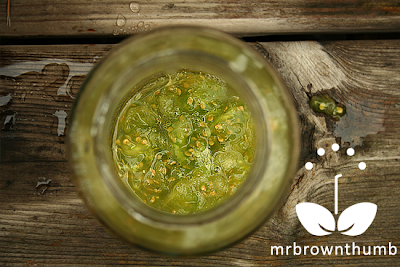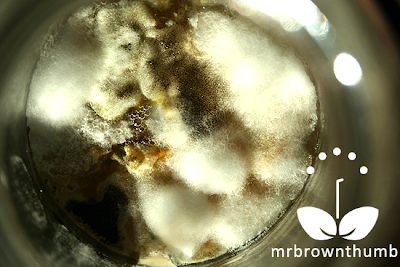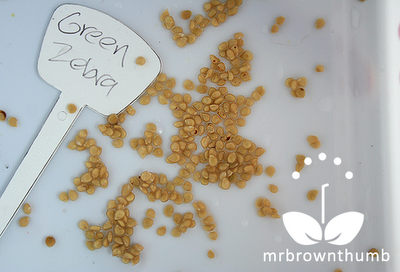Start by choosing the best tomato on your vine. If it is a slicing tomato cut it in half at its equator.
It is ok if you cut your tomato the other way to expose the seeds inside.
Next, you can squeeze out the inside, seeds, gel, juice and fruit or remove it with a spoon and place it into a container, like a jar, with a wide mouth.
To this mixture of tomato guts, you will add an inch or two of water and loosely close the lid. It may be a good idea to label your container with the name of the heirloom tomato you are saving so you don’t forget later on.
Set this aside for 2-3 days in a warm location outside of direct sunlight. What we are doing here is promoting fermentation that would naturally occur in nature when a tomato falls to the ground and rots. The reason we are fermenting the seeds is that the gelatinous material that surrounds seeds contains inhibitors that prevent the seeds from sprouting inside of the tomato.
As the fermentation process breaks down the gel that coats the seeds it will mold over and look like this.
Once you get to this point, you can scoop out the mold with a spoon. Seeds left in the mixture more than a few days will begin to germinate in the water. If you use a container that isn't very wide, add more water to the jar and allow the moldy layer to overflow out of the container. This is my favorite part of saving tomato seeds because it is so gross. Pour out as much of the water as you can without spilling any seeds. Slowly Refill the container with water and allow the seeds to settle. Remove any seeds that are floating at this point
Tomato seeds that float are duds. The tomato seeds you want to save are the nice plump seeds sitting at the bottom. Now you can rinse off the seeds one final time to make sure you get as much debris out as possible.
Finally set your seeds out in a plate and spread them out in a warm location to allow them to dry. Make sure to label the plate so you don't mix up the names, if you're doing more than one variety of seeds. It is perfectly fine to use a paper towel or plate to dry your seeds, the only downside of using paper is that your seeds may stick to the surface. Not a big deal, but it can get annoying to peel off dozens or hundreds of tomato seeds.
After your tomato seeds have dried out completely bag them up and save the tomato seeds for planting next year or share them with your friends. Congratulations, you are now a tomato seed saver.
Choosing a Tomato to Save Seeds From.
Obviously, in order for this to work you have to save seeds from a ripe, open-pollinated heirloom tomato. Tomato seed saving allows you the chance to play plant breeder. If you live in an area with a short growing season save seeds from the tomatoes that ripen first. If you like perfect-looking tomatoes save seeds from the most beautiful tomatoes on your vine. Choose the one with best color, uniformity in shape and size. If size and weight matter most to you save seeds from the biggest, fattest, heaviest tomatoes you grew. If you went on vacation and all of your tomato plants died except for one save seeds from that particular tomato plant. If you grew “Purple Cherokee” tomatoes and one tomato on the vine is a different color, save seeds from that tomato.
When you elect to save seeds from tomatoes with certain characteristics you find desirable you’re creating tomatoes lines that perform the best in your climate or have characteristics that matter to you.
Can I Save Tomato Seeds From the Grocery Store?
Yes and no. Yes, you can save tomato seeds from the tomatoes in your grocery store, but it is most likely a hybrid and the seeds may not grow a tomato similar to the one you ate.
Can I Save Seeds from Farmers Market Tomatoes?
If the farmer sold heirloom tomatoes, yes you can save seeds from the tomato at the farmers market. Although, there is a chance the plants cross-pollinated, creating a completely new hybrid. This isn’t a bad thing; it just means that you have a new tomato. If this happened, chances are remote but still a possibility, then the tomatoes you grow from these seeds will be different from the tomato you bought from the farmers market.
Saving heirloom tomato seeds is fun, rewarding and can save you money on your seed purchases. It also allows you to exercise your inner plant nerd, play tomato breeder, and really make you think about what makes that particular heirloom tomato so great. Inside of each of those tomato seeds is the story of your summer of tomato growing. The best thing to do with these tomato seeds is to put some away to plant next year and repeat this process every year. Share the rest of your saved tomato seeds with friends and family. After all, what good is it to have an heirloom if there is nobody to pass it down to?
If you're new to gardening check out my post on How to Save Seeds and How to Store Seeds. Interested in growing some of your own food? See my post on growing potatoes in a bucket and how to pollinate strawberry flowers.











What a great resource! I was hoping to try and save some seeds this year and you have made it look so easy. Tomatoes are my favorite. Trouble is getting to the seeds before I eat the fruit!
ReplyDelete@ThatBloomin'Garden, LOL. I found sitting down one afternoon to eat tomatoes like an apple (just a sprinkle of salt) and a spoon helped cut down on eating the seeds.
ReplyDeleteVery helpful, thanks!
ReplyDeleteI usually just scoop the seeds our, spread them onto paper towels, and let them dry. Most of these seeds have germinated, so I would say it works well enough. Might try this method at some point, though.
My family has saved seeds from a San Marzano type tomato for 100 years. We also spread the seeds on a paper towel and let them dry. I then place them in a clean envelope until ready to plant. Very easy and 100% germination.
DeleteThanks for putting up this illustrated guide. I've been wanting to save tomato seeds but am always put off the by fermentation and mold part. I think I can do it this time!
ReplyDeleteI can't wait to try this next year!
ReplyDeleteGreat info! Am curious about the fermentation breaking down inhibitors to germination, as that hasn't been my experience. You know how sometimes I'm lazy? The first year I saved seeds, I didn't do the fermentation step and my seeds all grew, for me and others in my first seed swap. I talked to a local heirloom tomato expert about it then, and he said the fermentation helps remove the gooey seed coat, which I did find to be true, but that it isn't necessary for seeds to germinate. In fact all the seeds he'd given me, which all ssprouted, had not been fermented. I do do that step now because it made the seeds way less gooey and easier to handle, esp. to get off the drying surface. For that, I initially used paper towels but the seeds really stuck to it, then used office paper, which was better, and finally paper plates at Colleen's suggestion, which worked best. :) Holla!
ReplyDeleteI have to go with Monica on this. I always thought it was best to ferment tomato seeds before saving them and my wife thought I was crazy. She didn't see the need to deal with the "icky" stuff. So I decided to test seed saving both with and without fermentation. I tested two different heirloom varieties. It turns out that the un-fermented seeds had much higher rates of germination and the plants were more vigorous. Could it be that fermentation is an urban myth perpetuated by the Internet? Well, I don't mean to sound like my test was scientific or anything. MrBrownThumb has been doing this for a long time. He has a ton of experience saving seeds.
DeleteI've read instructions for tomato seed saving before, but thanks for really getting step-by-step in detail on it. I hadn't heard of the floating duds before and that's pretty important info! Which reminds me, it's probably time to start selecting my seed donors....
ReplyDelete"Congratulations, you are not a tomato seed saver" - I think "not" should be "now" - either that or big props for the snarky attitude and ridcule!
ReplyDelete@AR, If your method works run with it. Whatever works best for a gardener is what they should do. I think I've saved some tomato seeds like you describe and haven't noticed any that didn't germinate. I think if I had a water hose where I could remove the gel with a strong blast of water I'd use that method. But since water pressure here is so weak I need the fermintation to remove it the gel.
ReplyDelete@MaryS,The fermintation of the seeds is what makes most people use the method that AR, above you describes, but I think the mold is the most fun. :0)
@Meemsnyc, Hope you do get a chance to try it.
@Monica, See the reply to AR. In re: to the fermintation I like the explanation from the mastergardeners.org website. The benefits of fermintation is that it breaks down the germination inhibitor, sorts out bad seeds and reduces some see-borne illnesses. http://is.gd/ffvoG (pdf)
@MaryC, You're welcomed.
@Anonymous, LMAO. No, that was a typo. While I am snarky there wasn't any snarky involved in the creation of this post. Thanks for pointing it out.
Thanks for the link. I do like that bad seeds float (like ducks and very small rocks) in the fermentation process. My local heirloom tomato guru told me there was no proof that fermentation reduces disease, but he didn't cite where he'd heard that. I'll ask him because I'm just geeky enough to want to understand the science/specific diseases, etc. I should have been a botanist!
ReplyDeleteI love that your favorite part is the gross part. That's pretty funny.
ReplyDeleteGreat info, Mr. BT! Wonderful reference here for the future! Thanks!
ReplyDeleteJulie
Thanks for sharing. Great tip.
ReplyDeleteVery helpful, although it's the wrong time of the year for me to be reading it; I'm about to go outside and start my tom seeds. I need to read this again in April. I'll set myself a reminder.
ReplyDeleteReally nice photos.
ReplyDeleteI have such a small garden that I buy a pack of seeds and they'll last forever. Still, the fermentation step was really interesting. Didn't realize that was important.
Thanks for the tips MBT! This is the first year I've formally saved seeds. I used to do it the lazy way and just let the fallen tomatoes lie and reseed.
ReplyDeleteI grow too many varieties now though, and want to make sure I'm replanting what I want to grow. This year I ended up with yellow pears that seeded themselves from last year. Since I'm not impressed with yellow pear, I didn't mean to grow them again this year.
Nice post!
I have never grown heirloom tomatoes. Where do you get seeds? I mean before you saved them, of course. I'd like to give it a a try.
ReplyDeleteYou do so many interesting things! Thank you for this very instructional/informative post! :-) Happy September!
ReplyDelete@Monica, If you find out let me know.
ReplyDelete@liz, It is the gross things that bring me so much joy in life.
@Elsie, You're welcomed. Thanks for stopping by and commenting.
@Terra, If I remember I'll spam your blog with a link to it in April. Kind of jealous that your gardening season is still going strong.
@Wendy, Me too. A pack can last me years since I only grow between two and four tomatoes.
@Garden Girl, I wish I had space to just let a tomato fall to the ground and wait for them next year. This is how I treat my sunflowers though.
@Jithofsteere, You can get seeds from many seed companies nowadays but there are some seed catalogs and online seed stores you can purchase from. of course you can also get them in trade and from tomatoes people give you.
@Shady Gardener, It only seems that way because I only blog about some things. It wouldn't look seem I do a lot of interesting things if I blogged about all the minutia of the garden. :0)
Thanks, but no need, MBT. I've already put the link into my calendar for April. :-)
ReplyDeletePenny
Nice post!!
ReplyDeleteThe floating part sounds especially important- thanks for writing this, Mr Brown Thumb.
ReplyDeleteMy garden hasn't produced any Stars, but I found a few nice heirlooms on sale today & have my spoon ready.
Annie at the Transplantable Rose
That looks very much like a tomato we know in Australia as a Green Zebra. That variety seems to tolerate humid subtropical conditions fairly well. The paper towel approach to saving tomato seeds also seems to work quite well.
ReplyDeletejack from Bellingen Seedsavers
Another Great Post! I made the mistake of drying out the seeds of a currant tomato on a paper towel, I nearly went MAD! but alas..the seeds were saved
ReplyDeleteThanks! Great info, going to go save some tomato seeds today!
ReplyDeleteDoes this work for tomatoes that have been refrigerated???
ReplyDeleteThis year, I'm using this ferment method to save seeds. I'm excited about saving the heirloom seeds I'm growing.
ReplyDeleteI re-read this post and found that you said the tomato seeds would start to germinate if left in water too long...so maybe that is what I can do...place them in a bit of shallow water to get them started, and then plant. I never want to wait too long to replant, since I live in south Florida (I don't have to wait till next year). Would this work with all fruit and vegie seeds??? I am dying to get those poblano seeds going asap!!!
ReplyDeleteThank you so much! Now I won't have to wait until my local nursery decides to get plants in stock, and I'll have VERY local and organic seeds! :D
ReplyDeleteHi. Would there be any chance I could get a few of your organic seeds?
DeleteWhen drying tomato seeds place them on waxed paper and they won't stick like they do on paper towels.
ReplyDeleteI grow a cherry tomato for drying called Principe Borghese. This year, when I was starting seeds I found I didn't have enough seeds, and the stores were sold out. So, just for kicks, I scraped seeds from one of the dehydrated tomatoes--and they grew! I was amazed that they had not come from a super-ripe tomato, had not been fermented, and had spent a couple of days in a dehydrator, and they still grew.
ReplyDeleteApparently P. Borghese is a preferred sundried variety. I couldn't locate them in my area this year.
DeleteWith GMO's and the move to seed control, we'd better start trading these things within the community.
In the Okanagan area of B.C. we have a seed trade fair in several areas in the early spring.
I was wondering if you could use this same process with all seeded plants???
ReplyDeleteThis is by far the best, most beautifully photographed and clearest post I've ever seen on this topic. Thanks for sharing, I have some heirloom seeds in water as I type!
ReplyDeleteGreat! I am eager to start saving my own seeds and I've heard about this process before. This is a beautifully illustrated, well written,and easily understood article. Thanks Mister Green Thumb! -Am
ReplyDeleteThanks for the feedback. Make sure to check out the tab on Seed Saving for more posts on how to save seeds.
Deletecan I save seeds at eating point or should I save from over ripe tomatoes?
ReplyDelete